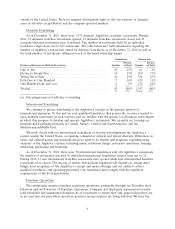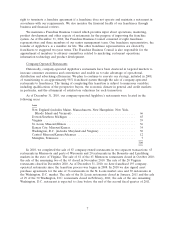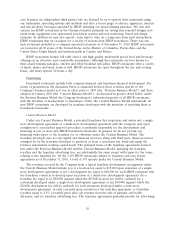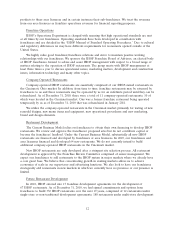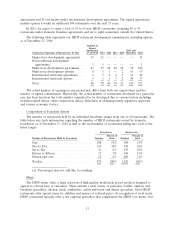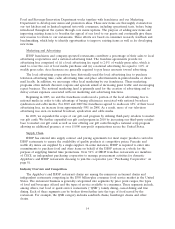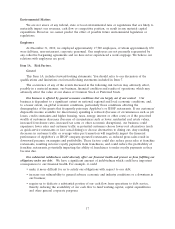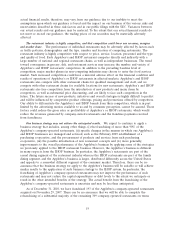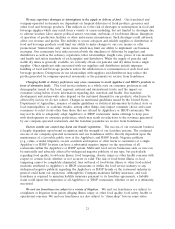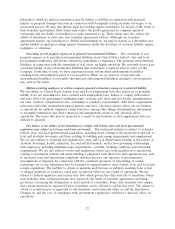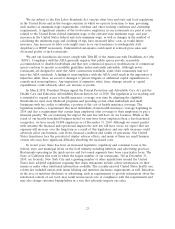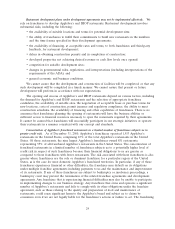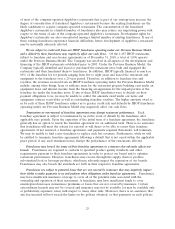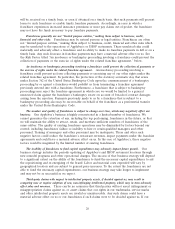IHOP 2010 Annual Report Download - page 32
Download and view the complete annual report
Please find page 32 of the 2010 IHOP annual report below. You can navigate through the pages in the report by either clicking on the pages listed below, or by using the keyword search tool below to find specific information within the annual report.relationship generally require that the franchisor deal with its franchisees in good faith, prohibit
interference with the right of free association among franchisees, limit the imposition of unreasonable
standards of performance on a franchisee and regulate discrimination against franchisees with respect
to charges, royalty fees or other fees. Although such laws may restrict a franchisor in the termination
and/or non-renewal of a franchise agreement by, for example, requiring ‘‘good cause’’ to exist as a basis
for the termination and/or non-renewal, advance notice to the franchisee of the termination or
non-renewal, an opportunity to cure a default and a repurchase of inventory or other compensation
upon termination, these provisions have not historically had a significant effect on our franchise
operations.
Each restaurant is subject to licensing and regulation by a number of governmental authorities,
which may include liquor license authorities (primarily in the case of Applebee’s restaurants), health,
sanitation, safety, fire, building and other agencies in the state or municipality in which the restaurant is
located. Difficulties in obtaining, or failure to obtain, the required licenses or approvals could delay or
prevent the development of a new restaurant in a particular area or cause the temporary closure of
existing restaurants. We are also subject to new laws and regulations, which vary from jurisdiction to
jurisdiction, relating to nutritional content and menu labeling. Compliance with these laws and
regulations may lead to increased costs and operational complexity and may increase our exposure to
governmental investigations or litigation.
We are subject to federal and state environmental regulations, but these have not had a material
effect on our operations. More stringent and varied requirements of local governmental bodies with
respect to zoning, land use and environmental factors could delay or prevent the development of new
restaurants in particular areas.
Various federal and state labor laws govern our and our franchisees’ relationships with our
respective employees. These include such matters as minimum wage requirements, overtime and other
working conditions. Significant additional government-imposed increases in minimum wages, paid leaves
of absence, mandated health benefits or increased tax reporting and tax payment requirements with
respect to employees who receive gratuities could be detrimental to the economic viability of our
restaurants.
In March 2010, President Obama signed the Patient Protection and Affordable Care Act and the
Health Care and Education Affordability Reconciliation Act of 2010. The legislation is far-reaching and
is intended to expand access to health insurance coverage over time by adjusting the eligibility
thresholds for most state Medicaid programs and providing certain other individuals and small
businesses with tax credits to subsidize a portion of the cost of health insurance coverage. The
legislation includes a requirement that most individuals obtain health insurance coverage beginning in
2014 and also a requirement that certain large employers offer coverage to their employees or pay a
financial penalty. We are evaluating the impact the new law will have on our business. Although we
cannot predict with certainty the financial and operational impacts the new law will have on us, we
expect that our expenses will increase over the long term as a result of this legislation, and any such
increases could adversely affect our business, cash flows, financial condition and results of operations.
In recent years, there has been an increased legislative, regulatory and consumer focus at the
federal, state and municipal levels on the food industry including nutrition and advertising practices.
Restaurants operating in the quick-service and fast-casual segments have been a particular focus. The
State of California, New York City and a growing number of other jurisdictions around the United
States have adopted regulations requiring that chain restaurants include calorie information on their
menus or make other nutritional information available. The recently-enacted United States health care
reform law included nation-wide menu labeling and nutrition disclosure requirements as well. Initiatives
in the area of nutrition disclosure or advertising, such as requirements to provide information about the
nutritional content of our food, may result in increased costs of compliance with the requirements and
may also change customer buying habits in a way that adversely impacts our sales.
16


